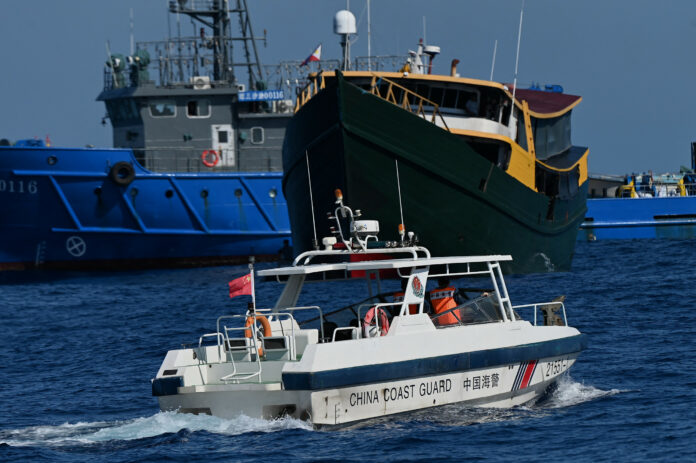A blockading Chinese force is again accused of employing aggressive measures in an attempt to stop a Philippine convoy from resupplying a Manila-held feature at a bitterly contested South China Sea feature on Saturday.
Manila said a supply boat was badly damaged and several personnel were injured by China Coast Guard water cannons. Chinese personnel also reportedly set up a barrier at Second Thomas Shoal.
The incident was, in many ways, a repeat of the last troop rotation and supply mission to the disputed atoll less than three weeks prior. That episode left four Philippine personnel injured after a Chinese water cannon shattered the windshield of one supply boat.
China claims sovereignty over Second Thomas Shoal, as it does most of the South China Sea, despite the fact the feature sits within the Philippines’ internationally recognized exclusive economic zone (EEZ) and over 600 miles from Chinese shores.
Jam Sta Rosa/AFP via Getty Images
What the Philippines says
“China Coast Guard and Chinese Maritime Militia vessels once again harassed, blocked, deployed water cannons, and executed dangerous maneuvers against the routine RoRe (rotation and resupply) mission to the BRP Sierra Madre,” the multi-agency National Task Force for the West Philippine Sea (NTF-WPS) said in a statement on Saturday.
Manila grounded the Sierra Madre at Second Thomas Shoal, known in the Philippines as Ayungin Shoal, in 1999 to stake its claim over the atoll. A contingent of Philippine marines are stationed on the dilapidated vessel, which Beijing maintains is illegal.
Starting around 4 a.m., Chinese coast guard and paramilitary vessels coordinated to obstruct the Philippine convoy, the NTF-WPS statement said, adding that Chinese water cannons reportedly disabled the supply boat and caused multiple injuries to those onboard.
Two escorting Philippine coast guard ships were able to break through obstructing Chinese ships to assist the stricken supply boat and provide assistance to her crew members.
The Sierra Madre then dispatched rigid-hulled inflatable boats to bring back supplies and the Philippine personnel being rotated in. The mission was deemed a success despite continued Chinese attempts to block it, including setting up a floating barrier at the mouth of the reef’s lagoon.
What China says
“A Philippine warship trespassed into the waters adjacent to China’s Ren’ai Jiao in an attempt to replenish its illegal beached warship,” Chinese Ministry of National Defense spokesperson Wu Qian said at a press briefing Sunday, using Beijing’s term for Second Thomas Shoal.
“The China Coast Guard regulated, stopped and drove away Philippine vessels in accordance with laws and regulations, and resolutely smashed Philippine attempts to infringe on rights and provoke,” the spokesperson added, calling the response by Chinese forces “reasonable, lawful, professional, and standardized.”
The statement said Beijing is willing to “resolve the dispute” through dialogue and negotiation and accused the Philippines of attempting to reinforce the rusting Sierra Madre.
Newsweek reached out to the Chinese embassy in the U.S. with a written request for comment outside office hours.
What the U.S. says
“The United States stands with its ally the Philippines and condemns the dangerous actions by the PRC against lawful Philippine maritime operations in the South China Sea on March 23,” State Department spokesperson Matthew Miller said Saturday, reiterating Manila’s claim that “repeated employment of water cannons and reckless blocking maneuvers” had crippled the supply boat and caused injuries.
Echoing Secretary of State Antony Blinken, who met with Philippine President Ferdinand Marcos Jr. and other officials in Manila last week, Miller added the allies’ 74-year-old defense treaty covers armed attacks on Philippine assets anywhere in the South China Sea.
What international law says
In 2016, a Hague-based international tribunal largely sided with the Philippines and dismissed China’s sweeping claims in the South China Sea.
In its landmark ruling, the tribunal cited the 1982 United Nations Convention on the Law of the Sea (UNCLOS), to which both states are signatories.
China refused to send a representative to the proceedings and has disregarded the ruling ever since, citing nebulous historical rights as the basis for its claims in the region.
What’s next?
Eduardo Ano, the Philippines’ National Security Advisor and chair of the NTF-WPS, called for a Monday meeting with the president’s executive secretary and Cabinet oversight committee on defense “for purposes of making recommendations to the president,” per the NTF-WPS statement.
“The Philippines shall continue to act peacefully and responsibly, consistent with international law, particularly UNCLOS and the legally binding 2016 Arbitral Award,” it added.
The country’s foreign affairs department summoned the Chinese embassy’s charge d’affaires Monday morning to “convey the Philippines’ strong protest” about Saturday’s events. The Southeast Asian nation’s embassy in Beijing had been ordered to lodge the same demarche, the department said.
Next month, President Joe Biden will host a summit with Marcos as well as Prime Minister Fumio Kishida of Japan, a U.S. defense treaty ally with its own territorial dispute with China. China’s conduct in the South China Sea is likely to feature in their discussions.
Uncommon Knowledge
Newsweek is committed to challenging conventional wisdom and finding connections in the search for common ground.
Newsweek is committed to challenging conventional wisdom and finding connections in the search for common ground.


